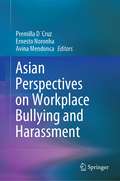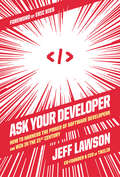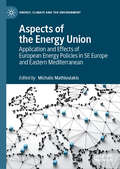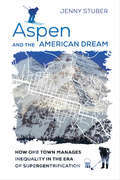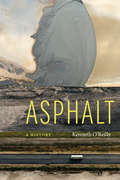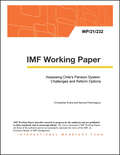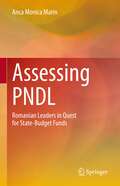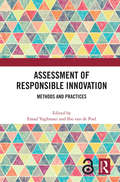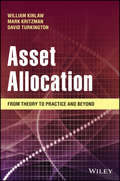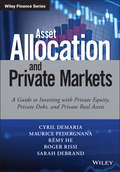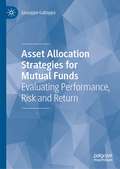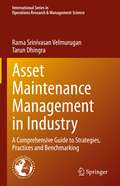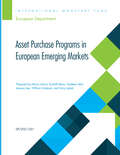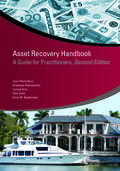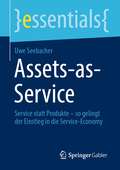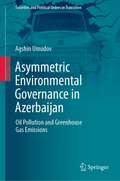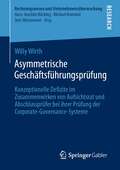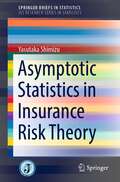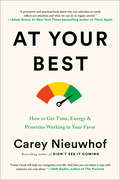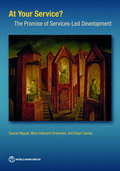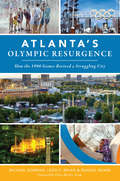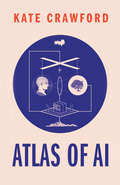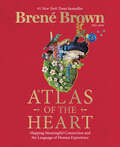- Table View
- List View
Asian Foreign Direct Investment in Europe (Routledge Studies in the Modern World Economy)
by Prana Krishna Biswas; Robert DygasThis book analyses the most recent trends in Foreign Direct Investment from the major Asian economies to the EU, focusing on China and Japan’s FDIs in the EU, and Poland in particular. The authors assert that, from a European perspective, there is a strong need for further Asian FDIs into EU nations, which will establish mutual benefits. This is the first book to explore the outflow of FDI from Asian nations to other countries, especially to EU member states, whereas the extant literature focuses on the inflow of FDI to Asian nations. The authors analyse a multidimensional range of issues, covering macroeconomics, finance, technology, and examine the governments, local authorities, and institutions that support such investments. FDI has an instrumental role in the development of host countries. Large-scale capital flow becomes a vehicle for providing foreign technology, knowledge, skills, and other inputs for the integration with international marketing, production, and distribution networks and for improving the economic competitiveness of firms and economic performance of the host country. The analysis in the book is presented using statistical and econometrical approaches, emphasising a profound level of investigation, which will be particularly useful for graduate and PhD students of International Economics, Business and Trade.
Asian Perspectives on Workplace Bullying and Harassment
by Premilla D’Cruz Ernesto Noronha Avina MendoncaThis book showcases empirical studies on workplace bullying from a range of Asian countries, including China, India, Indonesia, Israel, Japan, Jordan, Malaysia, Pakistan, Singapore, South Korea, Sri Lanka, Thailand, UAE and Vietnam, and is the first-of-its-kind single academic project documenting workplace emotional abuse in the world’s largest continent. It encompasses the ‘varieties of workplace bullying’ conceptualization in addition to category-based harassment and abusive supervision, and presents target, bystander and interventionist perspectives, along with contextualized insights into the phenomenon. The book speaks to the significance of sociocultural factors and draws on several theoretical and substantive bases including dignity, social cynicism, coping, gender, sexual orientation, job insecurity, turnover intention, affective events theory, attribution theory, regulation and policy initiatives. Covering all major regions in Asia where workplace bullying has been found to occur, namely West Asia, South Asia, Southeast Asia and East Asia, the book portrays studies which engage both positivist and postpositivist paradigms, utilize an array of methods and include a range of industrial sectors and employment contracts and all levels of the organization. While focused on Asia, the book’s insights have international relevance and are of interest to the worldwide community of researchers, practitioners and students of organizational studies, human resource management, industrial sociology, work psychology, industrial relations, labour law, corporate law, health sciences, social work and Asian studies.
Ask Your Developer: How to Harness the Power of Software Developers and Win in the 21st Century
by Jeff LawsonJeff Lawson, software developer turned CEO of Twilio, creates a new playbook for unleashing the full potential of software developers in any organization, showing how to help management utilize this coveted and valuable workforce to enable growth, solve a wide range of business problems and drive digital transformation.From banking and retail to insurance and finance, every industry is turning digital, and every company needs the best software to win the hearts and minds of customers. The landscape has shifted from the classic build vs. buy question, to one of build vs. die. Companies have to get this right to survive. But how do they make this transition?Software developers are sought after, highly paid, and desperately needed to compete in the modern, digital economy. Yet most companies treat them like digital factory workers without really understanding how to unleash their full potential. Lawson argues that developers are the creative workforce who can solve major business problems and create hit products for customers—not just grind through rote tasks. From Google and Amazon, to one-person online software companies—companies that bring software developers in as partners are winning. Lawson shows how leaders who build industry changing software products consistently do three things well. First, they understand why software developers matter more than ever. Second, they understand developers and know how to motivate them. And third, they invest in their developers' success. As a software developer and public company CEO, Lawson uses his unique position to bridge the language and tools executives use with the unique culture of high performing, creative software developers. Ask Your Developer is a toolkit to help business leaders, product managers, technical leaders, software developers, and executives achieve their common goal—building great digital products and experiences. How to compete in the digital economy? In short: Ask Your Developer.
Aspects of the Energy Union: Application and Effects of European Energy Policies in SE Europe and Eastern Mediterranean (Energy, Climate and the Environment)
by Michalis MathioulakisThis book provides a comprehensive exploration of some of the most critical issues regarding the EU’s Energy Union policy. Applied European energy policies face a number of challenges ranging from the geopolitics of energy and energy regulation, to climate change, advancing renewable and gas technologies, and consumer empowerment structures. This book takes a multi-dimensional look into some of these vital issues regarding the European energy sector with a special focus on the effects the Energy Union policy has in two sensitive regional systems, Southeastern Europe and the Eastern Mediterranean.Energy, being by definition a multi-disciplinary field, presents a challenge for readers of any specific disciplinary background that need to grasp an overall understanding of the various aspects of this exciting sector. This book’s objective is to offer the opportunity for readers to get a quality, hands-on overview of the Energy Union by the professionals and academics that interact with it on a daily basis.
Aspen and the American Dream: How One Town Manages Inequality in the Era of Supergentrification
by Jenny StuberHow is it possible for a town to exist where the median household income is about $73,000, but the median home price is about $4,000,000? Boring into the "impossible" math of Aspen, Colorado, Stuber explores how middle-class people have found a way to live in this supergentrified town. Interviewing a range of residents, policymakers, and officials, Stuber shows that what resolves the math equation between incomes and home values in Aspen, Colorado—the X-factor that makes middle-class life possible—is the careful orchestration of diverse class interests within local politics and the community. She explores how this is achieved through a highly regulatory and extractive land use code that provides symbolic and material value to highly affluent investors and part-year residents, as well as less-affluent locals, many of whom benefit from an array of subsidies—including an extensive affordable housing program—that redistribute economic resources in ways that make it possible for middle-class residents to live there.Stuber further examines how Latinos, who provide much of the service work in Aspen and who tend to live outside the town, fit into the social geography of one of the most unequal places in the country. Overall, Stuber argues that the Aspen's ability to balance the interests of its diverse class constituencies is not a foregone conclusion; rather, it is the result of efforts by local stakeholders—citizens, government, developers, and vacationers—to preserve the town’s unique feel and value, and "keep Aspen, Aspen" in all its complex dynamics.
Asphalt: A History
by Kenneth O'ReillyLa Brea Tar Pits once trapped prehistoric mammals. Today that killer has a chemical cousin in the Athabasca oil sands of Alberta, Canada—immense deposits of natural asphalt destined for upgrading to synthetic crude oil. If the harvesting of this natural asphalt continues unabated, we might find ourselves stuck in a muck of a different kind. Humanity has used asphalt for thousands of years. This humble hydrocarbon may have glued the first arrowhead to the first shaft, but the changes wrought by this material are most dramatic since its emergence as pavement. Since the 1920s the automobile and blacktop have allowed unprecedented numbers of Americans to experience the beauty of their continent from the Adirondacks to the Rockies and beyond, to Big Sur and the Pacific Coast Highway. Blacktop roads, runways, and parking lots constitute the central arteries of our environment, creating a distinct &“political territory&” and a &“political economy of velocity.&” In Asphalt: A History Kenneth O&’Reilly provides a history of this everyday substance. By tracing the history of asphalt—in both its natural and processed forms—from ancient times to the present, O&’Reilly sets out to identify its importance within various contexts of human society and culture. Although O&’Reilly argues that asphalt creates our environment, he believes it also eventually threatens it. Looking at its role in economics, politics, and global warming, O&’Reilly explores asphalt&’s contribution to the history, and future, of America and the world.
Assessing Chile’s Pension System: Challenges and Reform Options (Imf Working Papers)
by Christopher Evans and Samuel PienknaguraA report from the International Monetary Fund.
Assessing PNDL: Romanian Leaders in Quest for State-Budget Funds
by Anca Monica MarinThis book provides an in-depth analysis of the distribution of funds by the National Program for Local Development (PNDL), Romania’s largest state funded budget program. It provides an objective assessment of the way state budget funds are allocated at the level of county councils and municipalities in urban and rural areas. It covers allocations of the second phase of program implementation, namely the reformed PNDL II 2017-2020, which has double the volume of funds than the previous phase. Using a conceptual framework at the crossroads of sociology, public management, and public finance, this book provides necessary context for the complex funding environment of first and second tier level institutions in Romania.A comprehensive study on public administration, politicization, and development imbalances, this book will be of interest to researchers in public administration, sociology, and public finance, as well as politicians, civil servants, consultants, decision-makers, and representatives of responsible institutions with EU funds at national and EU level.
Assessment of Responsible Innovation: Methods and Practices
by Emad YaghmaeiResponsible Innovation encourages innovators to work together with stakeholders during the research and innovation process, to better align the outcomes of innovation with the values, needs and expectations of society. Assessing the benefits and costs of Responsible Innovation is crucial for furthering the responsible conduct of science, technology and innovation. However, there is until now only limited academic work on Responsible Innovation assessment. This book fills this lacuna. Assessment of Responsible Innovation: Methods and Practices presents tools for measuring, monitoring, and reporting upon the Responsible Innovation process and the social, environmental, scientific, and economic impacts of innovations. These tools help innovators to mitigate risk and to strengthen their strategic planning. This book aligns assessment tools and practices with the UN Sustainable Development Goals (SDGs). The prospects as well as the limitations of various Responsible Innovation assessment approaches and tools are discussed, as well as their applicability in various industry contexts. The book brings together leading scholars in the field to present the most comprehensive review of Responsible Innovation tools. It articulates the importance of assessment and value creation, the different metrics and monitoring systems that can be deployed and the reporting mechanisms, including the importance of effective communication.
Asset Allocation: From Theory to Practice and Beyond (Wiley Finance Ser.)
by William Kinlaw Mark P. Kritzman David TurkingtonDiscover a masterful exploration of the fallacies and challenges of asset allocation In Asset Allocation: From Theory to Practice and Beyond—the newly and substantially revised Second Edition of A Practitioner’s Guide to Asset Allocation—accomplished finance professionals William Kinlaw, Mark P. Kritzman, and David Turkington deliver a robust and insightful exploration of the core tenets of asset allocation. Drawing on their experience working with hundreds of the world’s largest and most sophisticated investors, the authors review foundational concepts, debunk fallacies, and address cutting-edge themes like factor investing and scenario analysis. The new edition also includes references to related topics at the end of each chapter and a summary of key takeaways to help readers rapidly locate material of interest. The book also incorporates discussions of: The characteristics that define an asset class, including stability, investability, and similarity The fundamentals of asset allocation, including definitions of expected return, portfolio risk, and diversification Advanced topics like factor investing, asymmetric diversification, fat tails, long-term investing, and enhanced scenario analysis as well as tools to address challenges such as liquidity, rebalancing, constraints, and within-horizon risk. Perfect for client-facing practitioners as well as scholars who seek to understand practical techniques, Asset Allocation: From Theory to Practice and Beyond is a must-read resource from an author team of distinguished finance experts and a forward by Nobel prize winner Harry Markowitz.
Asset Allocation and Private Markets: A Guide to Investing with Private Equity, Private Debt, and Private Real Assets (Wiley Finance)
by Cyril Demaria Maurice Pedergnana Remy He Roger Rissi Sarah DebrandThe comprehensive guide to private market asset allocation Asset Allocation and Private Markets provides institutional investors, such as pension funds, insurance groups and family offices, with a single-volume authoritative resource on including private markets in strategic asset allocation. Written by four academic and practitioner specialists, this book provides the background knowledge investors need, coupled with practical advice from experts in the field. The discussion focuses on private equity, private debt and private real assets, and their correlation with other asset classes to establish optimized investment portfolios. Armed with the grounded and critical perspectives provided in this book, investors can tailor their portfolio and effectively allocate assets to traditional and private markets in their best interest. In-depth discussion of return, risks, liquidity and other factors of asset allocation takes a more practical turn with guidance on allocation construction and capital deployment, the “endowment model,” and hedging — or lack thereof. Unique in the depth and breadth of information on this increasingly attractive asset class, this book is an invaluable resource for investors seeking new strategies. Discover alternative solutions to traditional asset allocation strategies Consider attractive returns of private markets Delve into private equity, private debt and private real assets Gain expert perspectives on correlation, risk, liquidity, and portfolio construction Private markets represent a substantial proportion of global wealth. Amidst disappointing returns from stocks and bonds, investors are increasingly looking to revitalise traditional asset allocation strategies by weighting private market structures more heavily in their portfolios. Pension fund and other long-term asset managers need deeper information than is typically provided in tangential reference in broader asset allocation literature; Asset Allocation and Private Markets fills the gap, with comprehensive information and practical guidance.
Asset Allocation Strategies for Mutual Funds: Evaluating Performance, Risk and Return
by Giuseppe GalloppoThis book offers an overview of the best-working strategies in the field of equity and fixed income mutual fund-based portfolio management. This timely research considers different market conditions, such as global financial crises, across various geographical regions such as the USA and Europe. Combining academic and practical findings, the author presents a practitioner perspective on mutual fund-based portfolio strategies, appealing not only to finance scholars but also professionals within the asset management industry. This book synthesizes a large part of the academic research to date on the mutual fund industry by drawing from the most widely cited academic journals. The author makes a systematic use of numerical examples to facilitate the understanding of Investment themes organized around several important topics: size, diversification, flows, active management, volatility, performance persistence and rating.
Asset Maintenance Management in Industry: A Comprehensive Guide to Strategies, Practices and Benchmarking (International Series in Operations Research & Management Science #310)
by Rama Srinivasan Velmurugan Tarun DhingraThis book introduces readers to essential strategies, practices, and benchmarking for asset maintenance in operations intensive industries. Drawing on a case study from the oil and gas sector, it offers a methodology and practical solutions to help maintenance practitioners select and formulate an asset maintenance strategy, and to establish best maintenance practices at an organizational level using the frameworks developed here. It is intended for industry practitioners, young maintenance professionals, and students of engineering management who aspire to a career in operations intensive industries.
Asset Purchase Programs in European Emerging Markets (Departmental Papers)
by Marco Arena, Rudolfs Bems, Nadeem Ilahi, Jaewoo Lee, William Lindquist, and Tonny LybekA report from the International Monetary Fund.
Asset Recovery Handbook: A Guide for Practitioners, Second Edition (StAR Initiative)
by Jean-Pierre Brun Anastasia Sotiropoulou Larissa Gray ScottDeveloping countries lose billions each year through bribery, misappropriation of funds, and other corrupt practices. Much of the proceeds of this corruption find 'safe haven' in the world's financial centers. These criminal flows are a drain on social services and economic development programs, contributing to the impoverishment of the world's poorest countries. Many developing countries have already sought to recover stolen assets. A number of successful high-profile cases with creative international cooperation has demonstrated that asset recovery is possible. However, it is highly complex, involving coordination and collaboration with domestic agencies and ministries in multiple jurisdictions, as well as the capacity to trace and secure assets and pursue various legal options—whether criminal confiscation, non-conviction based confiscation, civil actions, or other alternatives. This process can be overwhelming for even the most experienced practitioners. It is exceptionally difficult for those working in the context of failed states, widespread corruption, or limited resources. With this in mind, the Stolen Asset Recovery (StAR) Initiative has developed and updated this Asset Recovery Handbook: A Guide for Practitioners to assist those grappling with the strategic, organizational, investigative, and legal challenges of recovering stolen assets. A practitioner-led project, the Handbook provides common approaches to recovering stolen assets located in foreign jurisdictions, identifies the challenges that practitioners are likely to encounter, and introduces good practices. It includes examples of tools that can be used by practitioners, such as sample intelligence reports, applications for court orders, and mutual legal assistance requests. StAR—the Stolen Asset Recovery Initiative—is a partnership between the World Bank Group and the United Nations Office on Drugs and Crime that supports international efforts to end safe havens for corrupt funds. StAR works with developing countries and financial centers to prevent the laundering of the proceeds of corruption and to facilitate more systematic and timely return of stolen assets.
Assets-as-Service: Service statt Produkte – so gelingt der Einstieg in die Service-Economy (essentials)
by Uwe SeebacherDas Buch beschreibt pragmatisch und leicht verständlich das bewährte Assets-as-Service (AAS)-Prozessmodell des Autors. Das Modell besteht aus vier Schritten, die Unternehmen ohne große Investitionen und Risiken umsetzen können, um in kurzer Zeit in der Netflix-Economy profitabel zu werden und damit nachhaltige Wettbewerbsvorteile zu sichern. Darüber hinaus wird das AAS-Self-Assessment-Tool erläutert, mit dem Manager sofort die eigene Organisation hinsichtlich ihrer Readiness in Bezug auf AAS und die Abo-Ökonomie bewerten können, um zu wissen, wo sie mit welchen Maßnahmen gezielt und effektiv in der Abo-Wirtschaft ansetzen müssen.
Asymmetric Environmental Governance in Azerbaijan: Oil Pollution and Greenhouse Gas Emissions (Societies and Political Orders in Transition)
by Agshin UmudovThis book examines why authoritarian governments are willing to address environmental problems that have an international impact, such as CO2 emissions, but are reluctant to address problems that have only a domestic impact. In a case study of Azerbaijani oil politics, it demonstrates how the incumbent Azerbaijani regime has taken important measures trying to address CO2 emissions while ignoring the damage caused by oil pollution on the Caspian coast. The book argues that resource-rich authoritarian governments are eager to join international environmental initiatives to improve their image, but they address domestic environmental issues mainly if they threaten their hold on power.This book is an important contribution to scholarship on environmental governance in the post-Soviet space, an area that is poorly researched. Therefore, it is a must-read for researchers and scholars interested in post-Soviet studies, as well as in the nexus between mineral-rich regions and how social policy is created, e.g., environment, education, and healthcare. In addition, this book will be of tremendous importance for policymakers and international organizations as it looks into the motivation of authoritarian states in the post-Soviet space for environmental measures.
Asymmetrische Geschäftsführungsprüfung: Konzeptionelle Defizite im Zusammenwirken von Aufsichtsrat und Abschlussprüfer bei ihrer Prüfung der Corporate-Governance-Systeme (Rechnungswesen und Unternehmensüberwachung)
by Willy WirthObwohl der Pflichtenkreis des Aufsichtsrats seit der Jahrtausendwende umfassend erweitert wurde (sog. Professionalisierung) und obwohl die gesetzliche Abschlussprüfung im Zuge der europäischen Reform der Abschlussprüfung von 2014 in nahezu allen Facetten tiefgreifend reformiert wurde, offenbarte die Insolvenz des seinerzeit im DAX 30 gelisteten Zahlungsdienstleistungsunternehmens Wirecard im Jahr 2020 ein davon scheinbar unberührt fortbestehendes Defizit der aktienrechtlichen Unternehmensüberwachung in Deutschland. Die Arbeit ist darauf gerichtet, die konzeptionelle Ausgestaltung der aktienrechtlichen Unternehmensüberwachung und Prüfung im Laufe der jüngeren Vergangenheit zu ergründen und hierbei den Grad und die Form des Zusammenwirkens von Aufsichtsrat und Abschlussprüfer einer Systematisierung zu unterziehen. Dabei werden die Ursachen für die defizitäre Unternehmensüberwachung der kapitalmarktorientierten Aktiengesellschaft aufgezeigt und schließlich Lösungsvorschläge für eine Korrektur und Weiterentwicklung des aktienrechtlichen Überwachungssystems abgeleitet.
Asymptotic Statistics in Insurance Risk Theory (SpringerBriefs in Statistics)
by Yasutaka ShimizuThis book begins with the fundamental large sample theory, estimating ruin probability, and ends by dealing with the latest issues of estimating the Gerber–Shiu function. This book is the first to introduce the recent development of statistical methodologies in risk theory (ruin theory) as well as their mathematical validities. Asymptotic theory of parametric and nonparametric inference for the ruin-related quantities is discussed under the setting of not only classical compound Poisson risk processes (Cramér–Lundberg model) but also more general Lévy insurance risk processes. The recent development of risk theory can deal with many kinds of ruin-related quantities: the probability of ruin as well as Gerber–Shiu’s discounted penalty function, both of which are useful in insurance risk management and in financial credit risk analysis. In those areas, the common stochastic models are used in the context of the structural approach of companies’ default. So far, the probabilistic point of view has been the main concern for academic researchers. However, this book emphasizes the statistical point of view because identifying the risk model is always necessary and is crucial in the final step of practical risk management.
At Your Best: How to Get Time, Energy, and Priorities Working in Your Favor
by Carey Nieuwhof&“A perceptive and practical book about why our calendars so rarely reflect our priorities and what we can do to regain control.&”—ADAM GRANT &“Carey&’s book will help you reorganize your life. And then you can share a copy with someone you care about.&”—SETH GODIN You deserve to stop living at an unsustainable pace. An influential podcaster and thought leader shows you how. Overwhelmed. Overcommitted. Overworked. That&’s the false script an inordinate number of people adopt to be successful. Does this sound familiar: ● Slammed is normal. ● Distractions are everywhere. ● Life gets reduced to going through the motions. Tired of living that way? At Your Best gives you the strategies you need to win at work and at home by living in a way today that will help you thrive tomorrow. Influential podcast host and thought leader Carey Nieuwhof understands the challenges of constant pressure. After a season of burnout almost took him out, he discovered how to get time, energy, and priorities working in his favor. This approach freed up more than one thousand productive hours a year for him and can do the same for you. At Your Best will help you ● replace chronic exhaustion with deep productivity ● break the pattern of overpromising and never accomplishing enough ● clarify what matters most by restructuring your day ● master the art of saying no, without losing friends or influence ● discover why vacations and sabbaticals don&’t really solve your problems ● develop a personalized plan to recapture each day so you can break free from the trap of endless to-dos Start thriving at work and at home as you discover how to be at your best.
At Your Service?: The Promise of Services-Led Development
by Gaurav Nayyar Mary Hallward-Driemeier Elwyn DaviesManufacturing-led development has provided the traditional model for creating jobs and prosperity. But in the past three decades the conventional pattern of structural transformation has changed, with the services sector growing faster than the manufacturing sector. This raises critical questions about the ability of developing economies to close productivity gaps with advanced economies and to create good jobs for more people. At Your Service? The Promise of Services-Led Development (www.worldbank.org/services-led-development) assesses the scope of a services-driven development model and policy directions that can maximize the model’s potential.
Atlanta’s Olympic Resurgence: How the 1996 Games Revived a Struggling City
by Michael Dobbins Leon S. Eplan Randal RoarkThe summer of 1996. In nineteen days, six million visitors jostled about in a southern city grappling with white flight, urban decay and the stifling legacy of Jim Crow. Six years earlier, a bold, audacious partnership of a strong mayor, enlightened business leaders and Atlanta's Black political leadership dared to bid on hosting the 1996 Olympic Games. Unexpectedly, the city won, an achievement that ignited a loose but robust coalition that worked collectively, if sometimes contentiously, to prepare the city and push it forward. This is a story of how once-struggling Atlanta leveraged the benefits of the Centennial Games to become a city of international prominence. This improbable rise from the ashes is told by three urban planning professionals who were at the center of the story.
Atlas of AI: Power, Politics, and the Planetary Costs of Artificial Intelligence
by Kate CrawfordThe hidden costs of artificial intelligence, from natural resources and labor to privacy, equality, and freedom&“Eloquent, clear and profound—this volume is a classic for our times. It draws our attention away from the bright shiny objects of the new colonialism through elucidating the social, material and political dimensions of Artificial Intelligence.&”—Geoffrey C. Bowker, University of California, Irvine What happens when artificial intelligence saturates political life and depletes the planet? How is AI shaping our understanding of ourselves and our societies? In this book Kate Crawford reveals how this planetary network is fueling a shift toward undemocratic governance and increased racial, gender, and economic inequality. Drawing on more than a decade of research, award‑winning science, and technology, Crawford reveals how AI is a technology of extraction: from the energy and minerals needed to build and sustain its infrastructure, to the exploited workers behind &“automated&” services, to the data AI collects from us. Rather than taking a narrow focus on code and algorithms, Crawford offers us a political and a material perspective on what it takes to make artificial intelligence and where it goes wrong. While technical systems present a veneer of objectivity, they are always systems of power. This is an urgent account of what is at stake as technology companies use artificial intelligence to reshape the world.
Atlas of the Heart: Mapping Meaningful Connection and the Language of Human Experience
by Brené BrownIn her latest book, five-time #1 New York Times bestselling author Dr. Brené Brown writes, “If we want to find the way back to ourselves and one another, we need language and the grounded confidence to both tell our stories and to be stewards of the stories that we hear. This is the framework for meaningful connection".
Attaining Inner Peace in Islam: Said Nursi’s Perspective
by Zuleyha KeskinThis book discusses inner peace from an Islamic theological and spiritual perspective, the writings of Said Nursi, a twentieth century Muslim scholar. Inner peace is a topic of great interest in the world at present. While happiness and mental health have been extensively discussed from a psychological and sociological perspective, and while inner peace has been written about from various religious viewpoints, there is very little scholarly work on inner peace from an Islamic theological and spiritual perspective. This book addresses this significant gap. With Islam being the second largest religion in the world, this book provides an important contribution to the literature on a faith tradition which is followed by so many. In addressing the intersection between Islam, spirituality and psychology, this book makes an original contribution to the literature on modern Islamic thinkers like Nursi, and to the broader fields of Islamic studies, and theology, philosophy and well-being studies.

